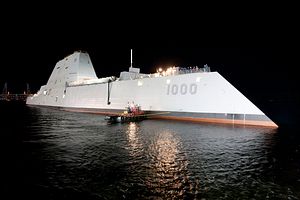The U.S. Navy is changing the mission requirements of its Zumwalt-class destroyers to be surface strike platforms against other warships. Originally conceived to support troops ashore with long-range precision bombardment, the U.S. Navy now wants to leverage its stealth, advanced sensors, and new gun system to counter expanding and increasingly sophisticated surface fleets, but must overcome challenges with its main armament.
At nearly 15,000 tons, the Zumwalt-class destroyers are half-again the size of the Arleigh Burke-class destroyers that now make up the core of the U.S. Navy’s surface combatant force. Following the warship’s original core mission to provide fire support against shore targets, their principal armament is two 155-millimeter Advanced Gun Systems. Unlike the U.S. Navy’s AEGIS destroyers and cruisers, which were designed around their generic missile launcher systems, the Zumwalt has only 80 missile launcher cells, compared to an Arleigh Burke destroyer’s 96 and a Ticonderoga-class cruiser’s 122.
Rear Admiral Ronald Boxall, the U.S. Navy’s director of surface warfare, told USNI News that Zumwalt’s mission requirement for providing fire support ashore was written in 1995, but that the current strategic environment demanded a reevaluation of the ship’s role and a reorientation toward surface strike instead of land attack.
During the Reagan administration, the U.S. Navy reactivated several World War II-era Iowa-class battleships with their massive 16-inch guns to provide, among other things, a potent fire support capability for amphibious landings. By 1992, they had all been decommissioned again as part of the post-Cold War draw-down. This left the U.S. Navy with nothing more powerful than a 5-inch gun with a range of about 14 nautical miles to support Marines or other troops on shore. The requirements that became the USS Zumwalt were intended to fill the fire support gap left by the battleships.
However, despite articulating the need for a much larger, more capable fleet, the U.S. Navy will likely be challenged to keep it from declining in the coming decades. In a sign of the U.S. Navy’s strategic priorities, all three Zumwalt hulls will be based in the Pacific, where their long-range artillery could threaten China’s archipelagic bases in the South China Sea and help the United States offset its growing fleet, which some analysis assesses will surpass the U.S. Navy in number of ships in the next few years.
Realigning the Zumwalt destroyers to conduct surface strike is consistent with initiatives like the U.S. Navy’s Distributed Lethality concept, which seeks to mitigate its shipbuilding challenges by improving the offensive punch of individual ships that did not previously have potent sea combat capabilities.
Complicating the Zumwalt’s near-term utility as anti-surface platform, however, is its main battery, the Advanced Gun System.
When the destroyer was conceived primarily as a land attack platform, its main battery of two 155-millimeter guns was designed to fire a new advanced, long-range, guided artillery round, the Long Range Land Attack Projectile (LRLAP). Under the originally planned 32-hull Zumwalt-class, the cost per round would have made LRLAP a cost-effective alternative to large land attack missile systems like the Tomahawk cruise missile.
However, design and construction costs amid long-term budget battles in the U.S. Congress led to successive program cuts and now only three Zumwalts will be built. With the development costs now spread across fewer hulls, the LRAP’s cost ballooned to nearly $1 million per round, about the same as a single Tomahawk cruise missile, which has a range of nearly 1,000 miles, versus the LRLAP’s 60. As a result, the U.S. Navy cancelled the LRAP and is looking for alternative long-range, guided rounds.
The Excalibur artillery round appears to be the LRLAP’s likely replacement. With a 30-mile range, it’s reach is half the LRLAP’s but double the range of the U.S. Navy’s existing 5-inch gun systems, and at $70,000 per round, much more affordable.
Another alternative is the High Velocity Projectile developed for use by the Electromagnetic Rail Gun, an experimental energy weapon that uses magnetic force to push solid rounds nearly 100 miles at Mach 6. The Zumwalt was designed as a potential future platform for the railgun and was built with significant excess electrical generation capacity in anticipation of powering future energy weapons. However, reporting by Task & Purpose suggests that the development money for the railgun will soon dry up and the weapon may never be completed. Even so, the High Velocity Projectile can be fired from conventional, gunpowder propelled artillery tubes, significantly improving their performance and range.
Whether the Navy goes with the Excalibur or a future version of the High Velocity Projectile, neither can immediately be used by the Zumwalt. The Advanced Gun System was specifically designed to fire the now cancelled LRLAP, and it cannot fire any other round without significant modifications. Defense officials have told USNI News that studies are underway on how to make the Advanced Gun System accommodate new ammunition, and that the modifications to the three ships’ batteries might cost $250 million.
The Zumwalts are the U.S. Navy’s most advanced surface combatants and it is eager to leverage them for new, more pressing missions. Modifying them won’t be cheap, and the cost of re-engineering their boutique weapons systems to new threats begs the question of whether those development funds would not be more effectively spent on new anti-ship missile systems that are now closer to being deployed and can be fired from a variety of platforms.
































